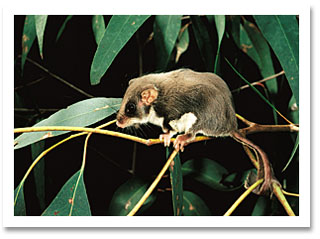
This small family of marsupials contains two genera, each with a single species, Acrobates pygmaeus in Australia and Distoechurus pennatus in New Guinea. Acrobates is a glider and has gliding membrane running from wrist to ankle. Distoechurus has no membrane, but several aspects of the biology of this species suggest that their ancestors had a membrane and the condition in Distoechurus is due to secondary loss.
Acrobatids are small, in fact, Acrobates is the world's smallest glider at 10-14 gms. Distoechurus is slightly larger, weighing around 50 gms. Both species feed primarily on nectar, and they both have long, brush-tipped tongues for retreiving nectar and pollen from flowers. They may also eat some insects.
These species can be characterized as members of the Diprotodontia with long, stiff hairs on either side of tail, that give it a feather-like appearance. This may originally have been an adaptation for steering while gliding. Like other members of their order, acrobatids are syndactylous and diprotodont.
The dental formula of acrobatids is 3/2, 1/0, 2-3/3, 3/3. Their molars are bunodont and quadritubercular; the upper premolars are secodont.
In the past, acrobatids have been classified with the burramyids. Recent evidence suggests that they may be more closely related to Tarsipes.
 feathertail gliderX |
Family Acrobatidae Family Burramyidae Family Macropodidae Family Petauridae Family Phalangeridae Family Phascolarctidae Family Potoroidae Family Pseudocheiridae Family Tarsipedidae Family Vombatidae<<<<<<<>>>>>>> ARTIODACTYLA CARNIVORA CETACEA CHIROPTERA DASYUROMORPHIA DERMOPTERA DIDELPHIMORPHI DIPROTODONTIA HYRACOIDEA INSECTIVORA LAGOMORPHA MACROSCELIDEA MICROBIOTHERIA MONOTREMATA NOTORYCTEMORPHIA PAUCITUBERCULATA PERAMELEMORPHIA PERISSODACTYLA PHOLIDOTA PRIMATES PROBOSCIDEA RODENTIA SCANDENTIA SIRENIA TUBULIDENTATA XENARTHRA
Email: eradani7@aol.com